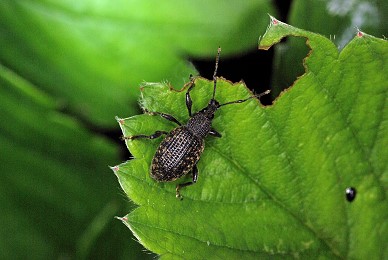Please click here to access the main AHDB website and other sectors.
- Home
- Knowledge library
- Vine weevil control in soft fruit crops
Vine weevil control in soft fruit crops
The vine weevil remains a major pest of soft fruit crops. Discover the life cycle and damage caused by this pest, and how it can be controlled.
This information was last updated in 2018.
 Roger Umpelby
Roger Umpelby
Adult vine weevil and characteristic notching on strawberry leaf.
What is a vine weevil
The vine weevil (Otiorhynchus sulcatus) is native to temperate areas of Europe including the UK.
The adult weevils feed on leaves, flowers and developing fruiting laterals.
The larvae feed on the roots and can cause severe damage.
Vine weevil adults can also fall or crawl into punnets and be a crop contaminant.
Which soft fruit crops are affected?
Many soft fruit crops can be damaged by the pest, including strawberry, raspberry, blackberry, currants and blueberry.
With many of these crops now grown under protection for at least part of the year, and in substrate rather than field soil, growing conditions are very suitable for vine weevil egg survival and larval development.
Key action points
- Check for adult activity and characteristic leaf notching from April onwards.
- Check around the roots and crowns for larvae by lifting some plants or knocking them out of their containers from March to November.
- Before planting plants provided in pots or trays, check a sample of plants for vine weevil larvae around the roots.
- Practise annual cropping of strawberry crops if possible, as keeping crops for more than one year increases the risk of vine weevil damage.
- Avoid planting strawberry plants into used bags or substrate in troughs as this will increase the risk of vine weevil infestation.
- In tabletop strawberries, consider using barrier glue on support legs to reduce the risk of adult vine weevils climbing up to strawberry plants.
- Plan a biological control strategy for vine weevil within an Integrated Pest Management (IPM) programme.
- Apply entomopathogenic nematodes in April/early May if live overwintered larvae are found. Repeat in late August and early September, making two applications 2-4 weeks apart.
- If considering using the entomopathogenic fungus Met52 Granular Bioinsecticide, use before planting in spring as an incorporation treatment or as a post-planting mulch if practical.
- Do not rely on Met52 alone for vine weevil control, but use as part of an IPM programme.
Biology, identification, and effects of crop type
Find a detailed look at the vine weevil's life cycle, the damage it causes and its impact on different crops and production systems.
Vine weevil biology and plant damage
Vine weevil sources of infestation, behaviour and monitoring
Controlling vine weevil in soft fruit
There are currently no conventional products approved for use as a drench for the control of vine weevil larvae on soft fruit crops. No products are currently recommended for use as a foliar spray for the control of adult weevils either. As a result, an Integrated Pest Management (IPM) programme should be planned carefully for effective management of vine weevil.
The IPM programme should include cultural and biological control methods, together with monitoring and selective use of products for the control of adults.
Follow the links below to read about how vine weevil can be controlled using cultural, biological or chemical methods:
Vine weevil in soft fruit: Cultural control
Vine weevil in soft fruit: Biological control – nematodes
Vine weevil in soft fruit: Biological control – nematode application methods
Vine weevil in soft fruit: Biological control – fungi and natural predators
Useful links
Biocontrol in Soft Fruit Guide
Vine weevil control in Hardy Nursery Stock
Beetle and weevil pests of cane fruit crops
Evaluation of insecticides for control of adult vine weevil under controlled conditions
Evaluation of Metarhizium anisopliae for control of black vine weevil in field grown strawberries
Download the original vine weevil control in soft fruit factsheet
Original author/s
Jude Bennison, Janet Allen & John Atwood, ADAS
Tom Pope, Harper Adams University
Topics:
Sectors:
Tags:

